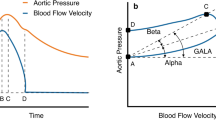Abstract
The present study was designed to follow the cardiovascular response to graded haemorrhage in two groups of adult rats of different ages. Group A (n=10) had a mean body weight (bwt) of 655 g (50 weeks old) and group B (n=10) had a mean bwt of 250 g (12 weeks old). After induction of anaesthesia, the carotid artery was cannulated for continuous intra-arterial blood pressure monitoring and for controlled haemorrhage. Five per cent of the total blood volume (TBV) was removed every 15 min until a maximum of 50% was reached. Mean arterial pressure (MAP) fell by 4–9 mm Hg each time 5% TBV was removed in both groups, and at the end of the study the MAP was comparable in the two groups (34±10 mm Hg in group A and 28±8 mm Hg in group B). There were no significant changes in heart rate (HR) in the young animals during haemorrhage, while there was a significant drop in heart rate in the older animals when blood loss exceeded 15% of TBV (P<0.05). A significant difference was also observed in HR between the two groups of animals with blood loss in excess of 20% TBV (P<0.05). It was concluded that although the hypotension induced by graded haemorrhage was similar in young and old rats, the older animals were less able to maintain their HR, probably as a consequence of age- and anaesthetic-related changes in sympathetic activity.
Similar content being viewed by others
References
Abboud FM (1979) Integration of reflex responses in the control of blood pressure and vascular resistance. Am J Cardiol 44:903–911
Bayshtok V, Hanf C (1988) Hemorrhagic shock. Anesthesiol Clin North Am 6:119–134
Crippen D, Safar P, Snyder C, Porter L (1991) Dying pattern in volume-controlled hemorrhagic shock in awake rats. Resuscitation 21:259–270
Ganong WF (1983) Circulation. In: Ganong WF (ed) Review of medical physiology, 11th edn. Launge, Los Altos, Calif, pp 510–515
Gerstenblith G, Lakatta EG, Weisfeld ML (1976) Age changes in myocardial function and exercise response. Prog Cardiovasc Dis 19:1–21
Gey KF, Burkhard WP, Pletscher A (1965) Variation of the norepinephrine metabolism of the rat heart with age. Gerontologia 11:1–11
Goldberg PA, Kreider MS, McLean MR, Roberts J (1986) Effects of aging at the adrenergic cardiac neuroeffector junction. Fed Proc 45:45–47
Guyton AC (1977) An overall analysis of cardiovascular regulation. Anesth Analg 56:761–768
Jönson C, Holm L, Jansson T, Fändriks L (1990) Effects of hypovolemia on blood flow, arterial [HCO −3 ], and HCO −3 output in the rat duodenum. Am J Physiol 259:G179-G183
Kirkman E, Little R (1988) The pathophysiology of trauma and shock. Baillières Clin Anaesthesiol 2:467–481
Lakatta EG, Gerstenblith GS, Angell CS, Shock NW, Weisfeld ML (1975) Diminished inotropic response of aged myocardium to cathecholamines. Circ Res 36:262–269
Lewis T (1932) Vasovagal syncope and the carotid sinus mechanism. BMJ 1:873–876
Little RA, Marshall HW, Kirkman E (1989) Attenuation of the acute cardiovascular responses to haemorrhage by tissue injury in the conscious rat. Q J Exp Physiol 74:825–833
Mazzeo RS, Grantham PA (1989) Sympathetic response to exercise in various tissues with advancing age. J Appl Physiol 66:1506–1508
Mazzeo RS, Horvath SM (1981) A decline in myocardial and hepatic norepinephrine turnover with age in Fischer 344 rats. J Physiol (Lond) 252:E762-E764
Mazzeo RS, Colburn RW, Horvath SM (1986) Effect of aging and endurance training on tissue catecholamine responses to strenuous exercise in Fischer 344 rats. Metabolism 35: 602–607
McGlew MJ, Safar P, Stremple P (1991) A simple survival model of volume-controlled hemorrhagic shock in awake rats. Resuscitation 21:247–257
Redfern WS, Little RA, Stoner HB, Marshall HW (1984) Effect of limb ischaemia on blood pressure and the blood pressure-heart rate reflex in the rat. Q J Exp Physiol 60:763–779
Roberts J, Goldberg PB (1976) Changes in basic cardiovascular activities during the lifetime of the rat. Exp Aging Res 2:487–517
Rocha E, Silva MR, Velasco IT (1992) Hemorrhagic shock: new experimental models and prehospital care. Curr Opin Anaesthesiol 5:258–262
Schadt JC, Ludbrook J (1991) Hemodynamic and neurohumoral responses to acute hypovolemia in conscious mammals. Am J Physiol 260:373–381
Secher NH, Bie P (1985) Bradycardia during reversible haemorrhagic shock—a forgotten observation? Clin Physiol 5:315–323
Secher NH, Sander-Jensen K, Werner C, Warberg J, Bie P (1984) Bradycardia during severe but reversible hypovolemic shock in man. Circ Shock 14:267–274
Seyde WC, Longnecker DE (1984) Anesthetic influences on regional hemodynamics in normal and hemorrhaged rats. Anesthesiology 61:686–698
Steinam RM, Denstedt OF (1969) Experimental production of hemorrhagic shock in the rat. Can J Physiol Pharmacol 47:305–310
Sykes MK, Adams AP, Finlay WEI, Wightman AE, Munroe JP (1970) The cardiorespiratory effects of haemorrhage and overtransfusion in dogs. Br J Anaesth 42:573–583
Wallenstein S, Zuckner CL, Fleiss JL (1980) Some statistical methods useful in circulation research. Circ Res 47:1–9
Wayonforth HB (1980) Experimental and surgical technique in the rat. Academic Press, London
Weil MH, Whigham H (1965) Corticosteroids for reversal of hemorrhagic shock in rats. Am J Physiol 209:815–818
Weiskopf RB, Townsley MI, Riordan KK, Chadwick K, Baysinger M, Mahoney E (1981) Comparison of cardiopulmonary responses to graded hemorrhage during enflurane, halothane, isoflurane and ketamine anesthesia. Anesth Analg 60:481–491
Weiss HR, Levy PJ, Kleinert HD, Murthy VS (1978) Alterations in brain and muscle oxygenation during hypovolemia and replacement with plasma substitutes in rats. Circ Shock 5:115–124
Wiggers HC, Inhraham RC, Dille J (1945) Hemorrhagic-hypotension shock in locally anesthetized dogs. Am J Physiol 143:126–133
Author information
Authors and Affiliations
Rights and permissions
About this article
Cite this article
Banic, A., Sigurdsson, G.H. & Wheatley, A.M. Influence of age on the cardiovascular response during graded haemorrhage in anaesthetized rats. Res. Exp. Med. 193, 315–321 (1993). https://doi.org/10.1007/BF02576239
Received:
Accepted:
Issue Date:
DOI: https://doi.org/10.1007/BF02576239




